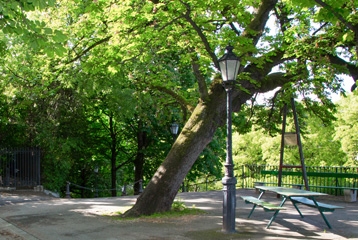While the history of la Cité, located at the very heart of Geneva, is long and turbulent, the sector of les Eaux-Vives primarily expanded during the 19th century following the construction of a port and the quays frequented by traders.
La Cité: from walls to an open city
The hill on which the current old town stands was already occupied in Antiquity by the Allobrogian oppidum of Genua, renamed Genava during the Roman colonisation.
By the 6th century, the city was becoming somewhat cramped within its enclosure dating back to the 3rd century. Trade intensified and a short-lived castle was built on the Place du Bourg-de-Four to monitor the passage. The fortifications were extended several times until the end of the 14th century. In the 16th century, town houses began appearing in the upper city and close to les Bastions.
During the course of its history, the City has often changed appearance. In times of peace and prosperity, it would become more open, sometimes even destroying its own ramparts. When threatened, however, it withdrew behind its fortifications and even razed entire suburbs, as it did at the time of l’Escalade.
In the mid-19th century, the city embraced its openness once and for all with the demolition of the fortifications. The old town was thus connected to the district of les Tranchées and the old suburb of Saint-Léger.
Les Eaux-Vives: from the port to the urban district
The land currently occupied by the sector of les Eaux-Vives was gradually reclaimed from the marshland. In the Middle Ages, it was called the Faubourg du Temple. Like all the city’s suburbs, it was razed in the 1530s to prevent the enemy from Savoy from advancing unseen. In the wake of the peace treaty signed with Savoy in 1603, this suburb renowned for its crafts slowly rebuilt itself.
In 1836-38, the port de la Scie was built, the first large port outside the walls of Geneva. The lake shore became a bustling quayside market. In 1862, the construction of the Mont Blanc Bridge provided a road link between les Eaux-Vives and les Pâquis.
The demolition of the fortifications in the 1850s accelerated the urbanisation of the district. At the beginning of the 20th century, the City’s acquisition of the La Grange and Eaux-Vives parks brought urban expansion to a halt.
Until 1930, les Eaux-Vives formed an independent municipality. The approval of the “Grande Genève” project led to the merger of Geneva, les Eaux-Vives, Plainpalais and le Petit-Saconnex.
Famous personalities in the district
Numerous personalities have been born, died or passed through the city. Names such as Jean-Jacques Rousseau, Milton, Jorge Luis Borges and Ferdinand Hodler are engraved on plates in the rue des Granges and la Grand-Rue. Franz Liszt also spent a number of years in the district with his lover, Marie d’Agoult. Rodolphe Töpffer, the inventor of the comic strip, was born on the Promenade Saint-Antoine. This artist was also a schoolmaster and ran a boarding house for young boys in the same district.
In 1920, in the Salle de la Réformation, les Eaux-Vives played host to a number of personalities who would leave their mark on the history of the world: they were the delegates of the first assembly of the League of Nations (LoN).
What do “Eaux-Vives” and “Molard” mean?
In the 14th century, the current region of les Eaux-Vives was called “Palluay”, from the Latin “pallus” meaning marshland. Subsequently, its numerous springs, which supplied the fountains of Geneva, earned it the name “Aygues vives” – les eaux vives or living waters. Several anecdotes recall the role of water in the district.
Previously, the lake came up to le Molard, where a commercial port was located until the beginning of the 19th century. “Molard” comes from “môle”, the name of the harbour wall that protected the entrance to the port.
Sources:
- Marcel Granger, Eaux-Vives, quartier de mémoire, Yens-sur-Morges, 2002.
- Doris Keller, (dir.), 100 ans de Bourg-de-Four: histoire vivante du siècle passé, Geneva, 2001.
- Christian Vellas and Gérard Chardonnens, Genève, Vieille-Ville, vieilles rues, Geneva, 1999.
Article modifié le 21.08.2023 à 11:46

